I commemorated the beginning of autumn last week with an article centered on an 1899 poem by William Thomas Saward published in The Girl’s Own Paper. That poem, titled Solitude, described the vitality of the season of fall:
For be it autumn, or be it spring, Some flowers will bloom, and some birds will sing!
As we turn the calendar from September to October, the first of two fully-autumn months, I again turn to The Girl’s Own Paper – this time the October 1, 1898 issue. This poem is most fitting for the season – so fitting that its name is Autumn. It is authored by a poet with the initials “V.R.” – you will find Autumn, reproduced in its entirety, below.
“Autumn”
Radiant sunsets garnered
Through the bygone year
From earth's deep bosom,
Slowly now appear.
Rainbow glories flooding
Forest, hill and vale,
With a ruby lustre
And an amber pale.
Now the forest minister
Trembles as each chord
Swells the rocking pine trees
On the wind's keyboard.
Till the music endeth
In an accent drear
Wailing out a requiem
To the dying year.
Earth her treasures gathered
From the seasons past.
Heapeth them an off'ring
On an altar vast!
Till the fires of Heaven
Catch the ascending glow.
And the heart of Heaven
Into earth doth flow.
Where is now the glory?
Where is Autumn's glow?
Passed into a furnace
Working deep below.
Forging through the darkness
Gems surpassing fair,
That the coming springtime
In her crown shall wear!
Envoi.
Garner—heart—the sunsets
Of thy passing years.
Bygone strains of music,
Remembered but in tears.
Till thy sorrow's—silent,
Alchemy transmute.
And each broken reed of song
Grows into a flute.
-V.R.
Parting Autumnal Thoughts

One theme in some of my New Leaf Journal content is looking for the unique charm of the different seasons. In Autumn – V.R. paints a distinct view of the charm of autumn. The season, we are told, is a requiem to the dying year. The poem – and especially its envoi – is a touch melancholic. But death is both an end and a beginning. It is here that V.R. states clearly the character of the fall – offering a different view than did Saward in Solitude:
Where is now the glory?
Where is Autumn's glow?
Passed into a furnace
Working deep below
In the envoi, V.R. more broadly associates autumn with remembering the past. Yet those sunsets of earlier days and the “bygone strains of music” will invariably “transmute” – and the Sun will rise and the birds will sing again.